Castro Theatre Renovation Uncovers, Decodes Artistic Treasures
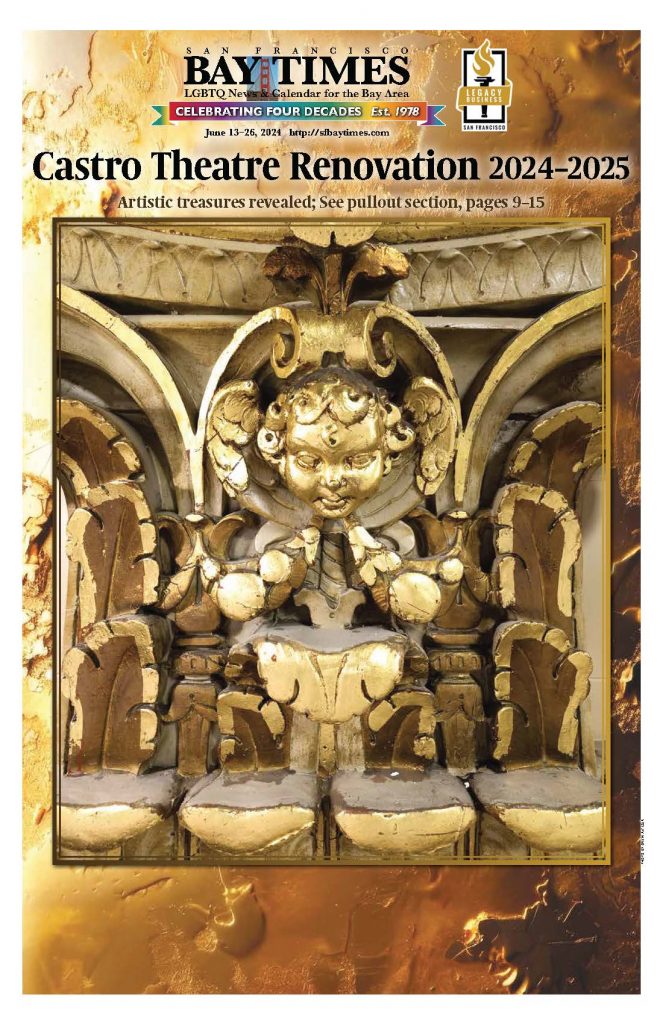
“Architecture is as much a response to place, a conversation with place, as it is a making of place.”
—Dr. Jeffery Malpas
The shapes, structures, and materials of a building can have a memory-like character, holding sensory properties that help imprint history and can impact us profoundly. The Castro Theatre has this effect on many of us, such that no matter one’s opinion about the unprecedented renovation taking place now at 429 Castro Street, emotions tend to run high. This was evident at last year’s debate concerning the future of the over-century-old theatre. Now that the restoration is well into the initial phase of the “glow-up”—work on the ceiling and walls—the theatre is more exposed than ever, revealing artistic and architectural elements that had been lost for decades.
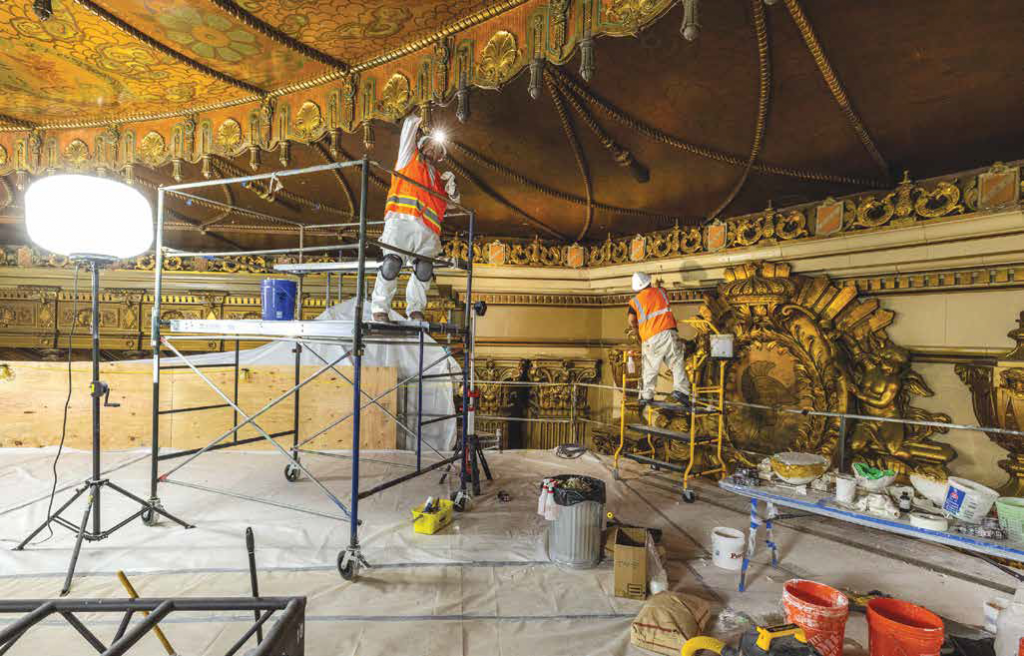
Rising Out of the Pandemic’s Darkest Days
Another Planet Entertainment (APE) Senior Vice President Mary Conde is the Project Manager for the Castro Theatre renovation project. The only independent, locally owned and operated full-service concert production company in Northern California, APE emerged from the legendary Bill Graham Presents, with Conde and Sherry Wasserman being among the women in leadership who now help run APE, which is in the top three of the nation’s largest such companies.
Conde told the San Francisco Bay Times that, during the dark days of the COVID-19 pandemic in 2020, APE kept everyone at the company on full payroll when many other businesses were downsizing or shutting altogether. She said, “We wanted another venue in San Francisco but this was at a time when people were even afraid to sit together in a car.”

project
Site visits were clearly challenging, but an APE real estate agent mentioned the Castro Theatre in a conversation. The agent shared that the families of Bay Properties, Inc., including the Nasser family whose ownership history goes back to the earliest days of the theatre, had since 2018 been working with experts on ways to modernize the building and make the business more financially viable. “They saw the writing on the wall, that the venue as it was could not be sustained,” Conde said.
In January 2022, APE announced that it had leased the Castro Theatre from Bay Properties. “It was kismet when everything came together,” Conde said. Fast forward to the present, when the estimated $15 million restoration is in the process of transforming the venerable theatre into a state-of-the-art mixed-use space for films, music, comedy and other stage shows, and more.
Cliff’s Variety and Castro Theatre Connections
APE is working with the renowned firm EverGreene Architectural Arts (EAA), which is providing design, restoration, and conservation services. EAA has also done this for the Empire State Building, the Library of Congress, Radio City Music Hall, Oakland’s Fox Theatre (additionally run by APE) and other well-known historic places.
In April 2024 it was announced that the theatre’s theatrical arch or proscenium, known to exist in historic photos and building plans, was revealed for the first time since the 1950s–1960s, when it was covered by a wide screen and associated wooden scaffolding. Since then, other key design aspects of the theatre have been uncovered after removal of dirt, smoke stains, and layers of varnish that were likely applied after the theatre was damaged as a result of the 1989 earthquake.
Legend has it that someone from the theatre went to Cliff’s Variety after the earthquake to purchase varnish. The late great Ernie Asten (1947–2019), longtime fourth generation patriarch of Cliff’s, is said to have advised him against the purchase, stating that it was not appropriate for the project and could hurt the art and plaster work. It is thought that he reinforced this view with a letter. While his widow Martha Asten, now the CFO of Cliff’s, could not fully confirm the story, she informed the San Francisco Bay Times that Ernie was known to offer this sort of advice to clients and write follow-up letters. The advice in this probable case was not heeded, the varnish was applied, and damage was done.
As an aside, the first Castro Theatre—following a small makeshift space at 18th and Collingwood Streets—was upgraded in 1910 by the Nassers to a 600-seat venue at 485 Castro Street, which is where Cliff’s is today. Asten said aspects of the theatre are still present in Cliff’s, such as the rounded ceiling and projection window.
A Gay Man’s Vision?
Architect, interior designer, and architectural lighting designer Timothy Ludwig Pflueger (1892–1946) was the mastermind behind the Castro Theatre. In 1920, the three Nasser brothers William, Elias, and George gave Pflueger a free hand in designing their planned 2,000-seat theatre with a budget of about $300,000, which equates to approximately $5.5 million today. Pflueger grew up in the Mission District in a working-class family—working as in he and his 6 brothers were expected to contribute to the family income as youths. Pflueger started at age 11 as a picture framer and later forged his way up the career ladder, with minimal formal education, in the architectural field.
Pflueger would have passed by the Mission Dolores Basilica nearly every day of his formative years, so it seems fitting that the façade of his first major theatre project pays homage to the basilica with its great arched central window surmounted by a scrolling pediment framing. It is in the California Churrigueresque or highly ornamental Spanish Baroque style.
Pflueger was said to have been “wedded to his work” and never married or had children. He and Julia Morgan (1872–1957) of Hearst Castle fame were contemporaries. She too never married or had children, and rocked neckties, suits, and plenty of butch mojo. While both never came out, there has been speculation that the two were members of the LGBTQ+ community, which was beyond closeted in those days. Regardless, their legacies have intertwined with queer history over the decades.
Also key to the Castro Theatre was Faggioni Co. Studios, which served as the official decorator. A 1926 ad for Faggioni proclaimed: “Our aim is, combining beauty and novelty of design thoroughly consistent with true art, in the decoration of theaters and large public edifices.”
Ceiling Restoration Confirms 1922 Account in the Motion Picture News
Various architecture experts and buffs over the years have speculated about the meaning behind the overall look of the Castro Theatre’s ceiling. The present restoration, however, confirms a story that appeared in the November 4, 1922, issue of Motion Picture News:
“The builders of the Castro, of which T.L. Pflueger was the architect, turned to the semi-exterior of court scheme in planning the interesting auditorium. It is suggestive of the Roman Amphitheatre, which consisted of stone walls, a cantilever roof over the stage, and a cloth canopy hung on ropes for the protection from the sun. Though the Roman design is predominant, there is a daring combination of Oriental and Spanish in detail ornamentation. The canopied ceiling is the climax of the architectural effect. It is made entirely of plaster, but seems to be of some fine fabric of rich design. It is fringed with tassels, valances, and cords, and is hung upon great golden ropes, all of which is plaster.”
It also appears to confirm Therese Poletti’s theory, published in her 2008 book Art Deco San Francisco: The Architecture of Timothy Pflueger, which holds that Pflueger was inspired by the Kinema Theatre in Fresno, which was constructed in 1913 but was destroyed by a fire just 6 years later. Note the similar look to the Castro’s ceiling in the historic photo of the Kinema here: https://bit.ly/3x9dHGu
32 Dragons Uncovered at the Castro Theatre During the Year of the Dragon
The artwork within the interior of the Castro Theatre includes at least 32 dragons, according to Conde, who said, “It seems fitting that the restoration has uncovered the dragons during the Year of the Dragon, with the dragon considered to be the most auspicious zodiac sign.”
The dragons, in part, frame ovate shapes that surround a series of very striking figures. Their tales form curvilinear shapes, evoking both Asian art and the fanciful images within The Book of Kells illuminated manuscript dating to the 9th century.
Originally painted in colorful hues of red, green, and other shades, the dragons are slowly coming back to visual life after being obscured.
Another influence on the theatre’s designers must have been the 1915 Panama-Pacific International Exposition. This immense fair—”when the world came to San Francisco,” as a 2015 documentary of that same name reports—received nearly 19 million visitors during the months that the exposition was open. Its impact on art and architecture is still seen to this day.
Homage to the Aztec Deity Quetzalcoatl
One of the vivid figures appears to depict Quetzalcoatl, who is a deity in Aztec culture. He became “the god of the morning and evening star,” and was a symbol of death and resurrection. One myth shares that “he embarked upon a raft made of snakes and disappeared beyond the eastern horizon.” In the Nahuatl language, Quetzalcoatl means “feathered serpent,” and he was regarded as “The Dragon of the New World,” perhaps helping to explain the many dragons within the theatre’s design.
Quetzalcoatl was also the god of learning, writing, and books. Another figure shows a pan flute player, clearly representing music. Yet another may show a half-human, half-goat faun. A production of Shakespeare’s A Midsummer Night’s Dream was popular at the time of the theatre’s construction, so the faun “Puck” from the play would have been familiar to visitors to the Castro. Taken together, the figures in the ovals therefore appear to touch on many aspects of the arts.

National Geographic Influences and a Possible Political Statement
Excavations of Aztec and other historic sites were reported in the pages of National Geographic magazine, which was founded in 1888 as a scholarly journal but over time became a very popular read for the general public. In 1905 it began publishing photos, and its first color photos began to appear in the 1910s. During the time of the Castro Theatre’s construction, the magazine was highlighting colorful images, including photos of individuals from different cultures around the globe.
The more realistic images of humans—not necessarily fantasy figures, but actual people—in the Castro’s interior are similar to the photos familiar to the public from the pages of National Geographic. The bare-breasted women might at first seem shocking, even for today’s moviegoers, but they were common in the magazine. This later became controversial, and the magazine subsequently admitted that the coverage was at times not respectful enough of different cultures.
Conde theorizes that, because Pflueger often used prominent Asian motifs in not only the Castro Theatre but also in many of his other projects, he might have been making a political statement during a time of the Chinese Exclusion Act, which was not repealed until l943. She is not alone in supporting that idea.
The Art Deco Society of New York, after studying another iconic Pflueger building, mentioned the following about his work: “The references to Chinese mythology and other Asian themes were bold and unusual in an era during which the 1882 Chinese Exclusion Act banning Chinese immigration was still in effect. The ceiling and other Chinese and Asian touches in the building, now known as 140 New Montgomery, show a clear appreciation of a culture deeply engrained in San Francisco’s history.”
It would take volumes to describe the many decorative elements of the theatre, including cherubs, laurel wreaths, crowns, Roman helmets, leaves, geometric shapes, and much more. In addition to the Churrigueresque style, Beaux-Arts, Renaissance, and other artistic traditions are evident in the theatre.
Inextricably Tied to the LGBTQ+ Community
When the San Francisco Bay Times was founded in the 1970s, the Castro District had become a beacon for the queer community. LGBTQ+ films were often presented at the Castro Theatre. During the HIV/AIDS crisis, the theatre became a refuge. Historian Gerard Koskovich told KQED, “It was a place to go after you got done with the two memorial services for people you knew that week. You could spend a couple of hours escaping to a movie, or a live show. You could bring people who were sick and they could sit calmly in a safe, secure, comfortable place and know they weren’t going to be excluded if they had signs [of AIDS], like Kaposi’s sarcoma lesions. That people weren’t going to pull away from them. They could remain part of the community that had been built there.”
The San Francisco Gay Men’s Chorus, drawing from that tradition and more, held its first Home for the Holidays concert on Christmas Eve of 1990. The tradition has continued for over three decades, although the concerts will not be possible for 2024 at the theatre due to the ongoing renovation.
Frameline, founded in 1977, is also deeply tied to the Castro Theatre. The theatre has been the hub of this festival, which is the longest-running, largest, and most widely recognized queer film exhibition event in the world. The theatre has even been featured prominently in certain queer films, such as the 2008 movie Milk about Harvey Milk.

Flame to Be Relit for Juneteenth Block Party
The theatre’s iconic vertical neon sign, also known as the blade or flame, is scheduled to be relit on Wednesday, June 19, for the first ever Juneteenth Block Party in the Castro. Taking place from 7–10 pm, the party will be held at the 400 block of Castro Street between Market and 18th Streets. Frameline will screen Lil Nas X: Long Live Montero, and there will be live drag performances, music from DJ Die Wies, food and drink available for purchase, and more. Photos on social media show the blade beautifully lit during recent evening testing, with the neon shining through its protective cover.
The theatre will still be closed, because after the initial renovation phase, work will move to the lower level and to other phases involving the sound system, bathrooms, electrical wiring, ADA compliance, preparation for the new digital organ, mezzanine level bar, the often-mentioned and previously debated seating, and more. Of concern is the asbestos and lead in the building, which is primarily a health threat when disturbed and airborne. Conde said that some of these substances have already been safely removed, but that work is not finished yet.
Conde herself has fond memories of the theatre, having gone to The Sound of Music, The Rocky Horror Picture Show, and other singalongs there back in the day. “This is a legacy project with a lasting impact for the better that will long outlive me,” she said.
Asten, who recently underwent a successful back surgery, is supportive of the work and looking forward to the theatre’s grand reopening in summer of 2025. She said, “I know that change is hard but it is inevitable and we must look to the future.” Even at Cliff’s her team has been busy changing out lights to conform to California Title 20, which has been phasing out incandescent and halogen products in favor of light-emitting diode (LED) ones.
Support Neighborhood Movie Theatres!
The changes and temporary closure of the Castro Theatre are a reminder to support other neighborhood movie theatres, such as The Roxie, Balboa, and Alamo in San Francisco, the Elmwood Theatre in Berkeley, the Grand Lake Theatre in Oakland, the New Parkway Theater in Oakland, the Alameda Theatre & Cineplex, the Orinda Theatre, and others. The Fox and Paramount Theatres in Oakland are not showing films now, but they are architectural gems nonetheless, with the Paramount being yet another of Pflueger’s masterpieces.
As Malpas holds, “When we build we do indeed build memory, and every building carries memory within it. What this means, however, is that when we neglect the memorial character of building, and so the way memory must also enter into building construction and design, we neglect an essential element in what it is to build. We thereby misunderstand building, and we also misunderstand ourselves.”
We are hopeful that the restoration of the Castro Theatre will continue to preserve its artistic treasures and retain the essence of the space while also evolving the legacy of Pflueger and the many others who have contributed to its creation and maintenance over the decades. Doing so helps strengthen our own memories of moments spent at the theatre, in good times and in bad, but always feeling like it was a welcoming home away from home, and especially for the LGBTQ+ community.
For updates on the Castro Theatre renovation, go to https://bit.ly/3Vj73p6
Drew Altizer Photography
The San Francisco Bay Times is grateful to Drew Altizer and Devlin Shand of Drew Altizer Photography for their exceptional work in recording this critical moment in time at the Castro Theatre. Shand is also the Co-Founder/Owner of Queer Arts Featured just steps away from the theatre at 575 Castro Street. Shand says, “Queer Arts Featured has worked with Another Planet Entertainment to salvage items from The Castro Theatre, including the film screen and some of the original floorboards, and turned them into the canvas for a living collaborative exhibition, Wet Paint. Every Wednesday night until July 24th, the exhibition is open space for anyone to creatively express themselves on pieces of history, and collaborate with works others have made before them.”
For more information:
Drew Altizer Photography: https://drewaltizer.com/
Queer Arts Featured: https://www.queerartsfeatured.com/
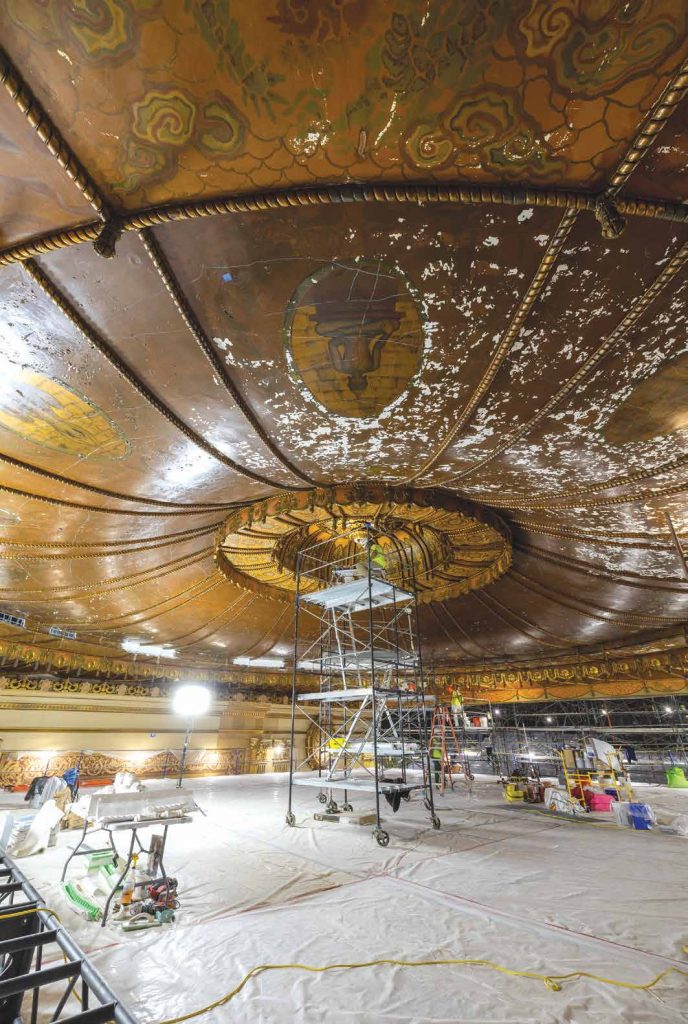
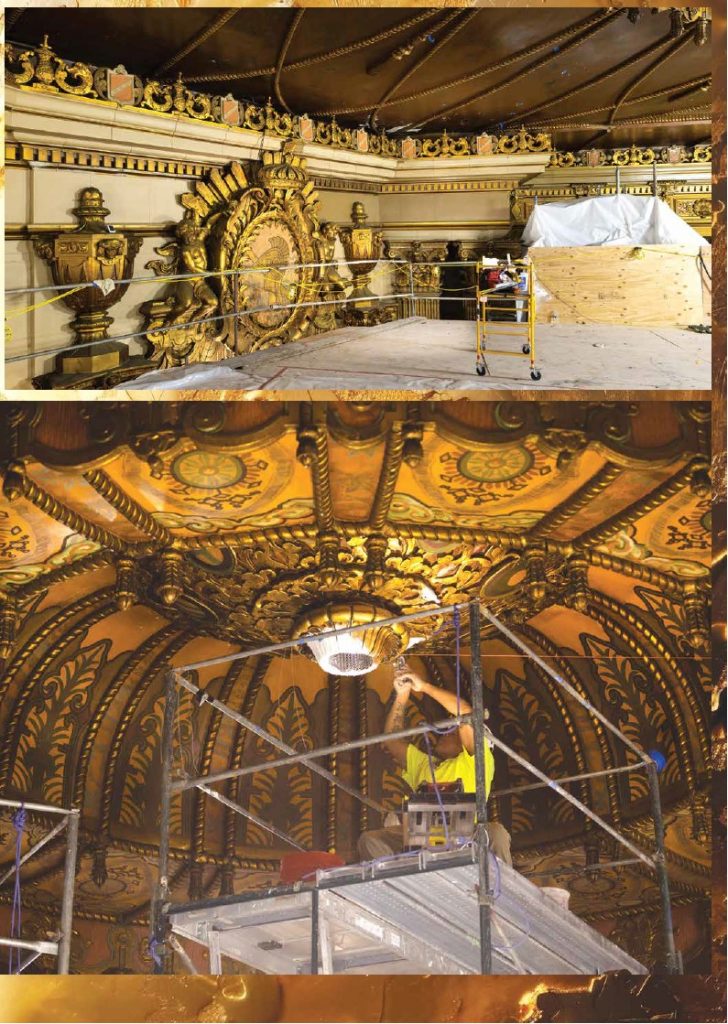
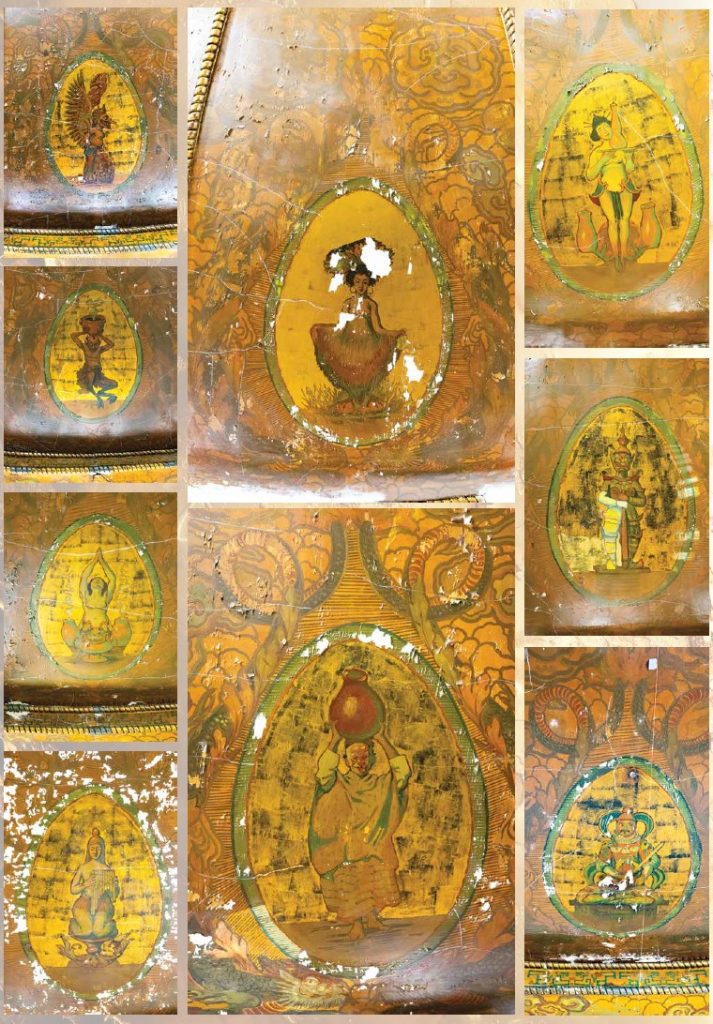
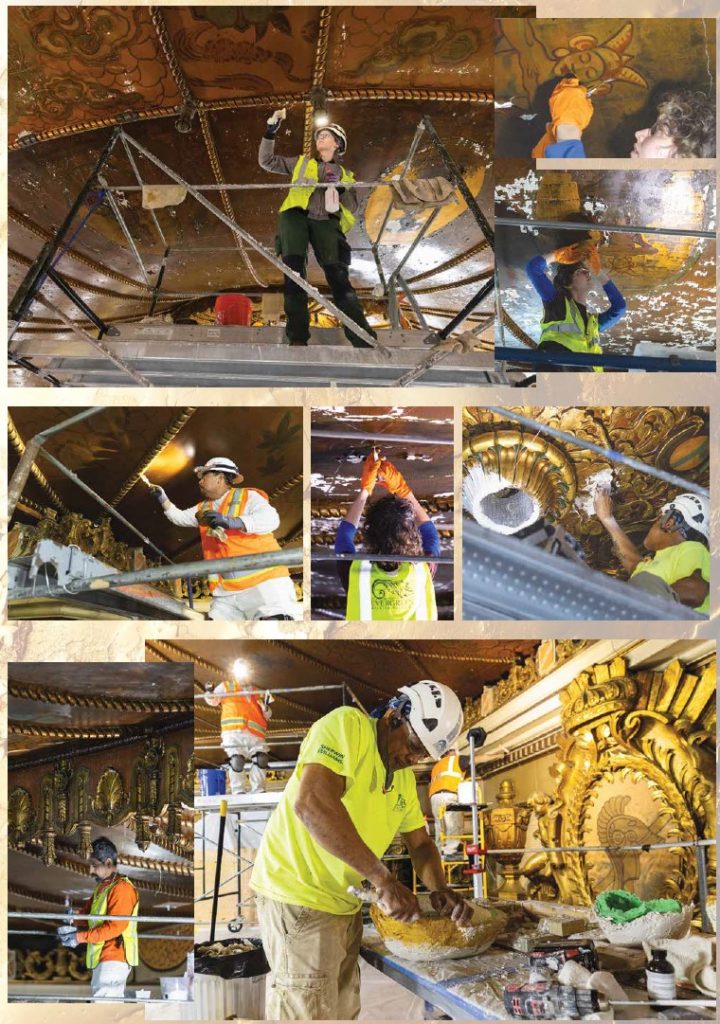
Published on June 13, 2024




Recent Comments